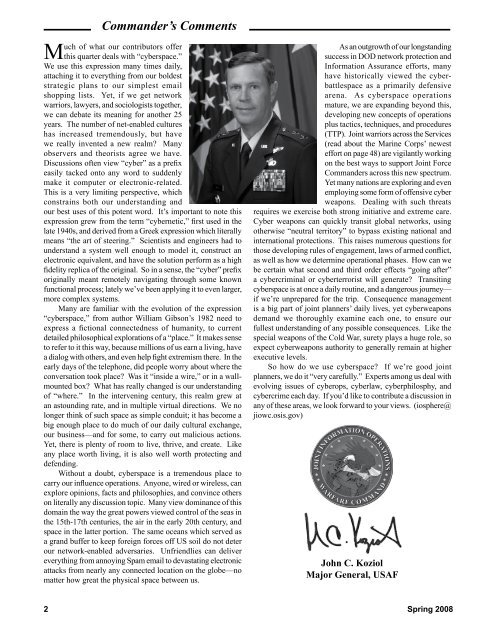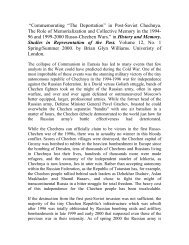Download - IO Sphere
Download - IO Sphere
Download - IO Sphere
You also want an ePaper? Increase the reach of your titles
YUMPU automatically turns print PDFs into web optimized ePapers that Google loves.
Commander’s Comments<br />
Much of what our contributors offer<br />
this quarter deals with “cyberspace.”<br />
We use this expression many times daily,<br />
attaching it to everything from our boldest<br />
strategic plans to our simplest email<br />
shopping lists. Yet, if we get network<br />
warriors, lawyers, and sociologists together,<br />
we can debate its meaning for another 25<br />
years. The number of net-enabled cultures<br />
has increased tremendously, but have<br />
we really invented a new realm? Many<br />
observers and theorists agree we have.<br />
Discussions often view “cyber” as a prefix<br />
easily tacked onto any word to suddenly<br />
make it computer or electronic-related.<br />
This is a very limiting perspective, which<br />
constrains both our understanding and<br />
our best uses of this potent word. It’s important to note this<br />
expression grew from the term “cybernetic,” first used in the<br />
late 1940s, and derived from a Greek expression which literally<br />
means “the art of steering.” Scientists and engineers had to<br />
understand a system well enough to model it, construct an<br />
electronic equivalent, and have the solution perform as a high<br />
fidelity replica of the original. So in a sense, the “cyber” prefix<br />
originally meant remotely navigating through some known<br />
functional process; lately we’ve been applying it to even larger,<br />
more complex systems.<br />
Many are familiar with the evolution of the expression<br />
“cyberspace,” from author William Gibson’s 1982 need to<br />
express a fictional connectedness of humanity, to current<br />
detailed philosophical explorations of a “place.” It makes sense<br />
to refer to it this way, because millions of us earn a living, have<br />
a dialog with others, and even help fight extremism there. In the<br />
early days of the telephone, did people worry about where the<br />
conversation took place? Was it “inside a wire,” or in a wallmounted<br />
box? What has really changed is our understanding<br />
of “where.” In the intervening century, this realm grew at<br />
an astounding rate, and in multiple virtual directions. We no<br />
longer think of such space as simple conduit; it has become a<br />
big enough place to do much of our daily cultural exchange,<br />
our business—and for some, to carry out malicious actions.<br />
Yet, there is plenty of room to live, thrive, and create. Like<br />
any place worth living, it is also well worth protecting and<br />
defending.<br />
Without a doubt, cyberspace is a tremendous place to<br />
carry our influence operations. Anyone, wired or wireless, can<br />
explore opinions, facts and philosophies, and convince others<br />
on literally any discussion topic. Many view dominance of this<br />
domain the way the great powers viewed control of the seas in<br />
the 15th-17th centuries, the air in the early 20th century, and<br />
space in the latter portion. The same oceans which served as<br />
a grand buffer to keep foreign forces off US soil do not deter<br />
our network-enabled adversaries. Unfriendlies can deliver<br />
everything from annoying Spam email to devastating electronic<br />
attacks from nearly any connected location on the globe—no<br />
matter how great the physical space between us.<br />
As an outgrowth of our longstanding<br />
success in DOD network protection and<br />
Information Assurance efforts, many<br />
have historically viewed the cyberbattlespace<br />
as a primarily defensive<br />
arena. As cyberspace operations<br />
mature, we are expanding beyond this,<br />
developing new concepts of operations<br />
plus tactics, techniques, and procedures<br />
(TTP). Joint warriors across the Services<br />
(read about the Marine Corps’ newest<br />
effort on page 48) are vigilantly working<br />
on the best ways to support Joint Force<br />
Commanders across this new spectrum.<br />
Yet many nations are exploring and even<br />
employing some form of offensive cyber<br />
weapons. Dealing with such threats<br />
requires we exercise both strong initiative and extreme care.<br />
Cyber weapons can quickly transit global networks, using<br />
otherwise “neutral territory” to bypass existing national and<br />
international protections. This raises numerous questions for<br />
those developing rules of engagement, laws of armed conflict,<br />
as well as how we determine operational phases. How can we<br />
be certain what second and third order effects “going after”<br />
a cybercriminal or cyberterrorist will generate? Transiting<br />
cyberspace is at once a daily routine, and a dangerous journey—<br />
if we’re unprepared for the trip. Consequence management<br />
is a big part of joint planners’ daily lives, yet cyberweapons<br />
demand we thoroughly examine each one, to ensure our<br />
fullest understanding of any possible consequences. Like the<br />
special weapons of the Cold War, surety plays a huge role, so<br />
expect cyberweapons authority to generally remain at higher<br />
executive levels.<br />
So how do we use cyberspace? If we’re good joint<br />
planners, we do it “very carefully.” Experts among us deal with<br />
evolving issues of cyberops, cyberlaw, cyberphilosphy, and<br />
cybercrime each day. If you’d like to contribute a discussion in<br />
any of these areas, we look forward to your views. (iosphere@<br />
jiowc.osis.gov)<br />
John C. Koziol<br />
Major General, USAF<br />
2 Spring 2008




